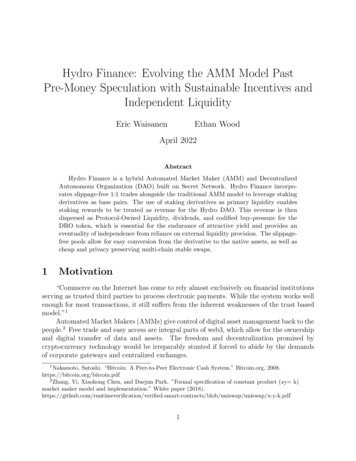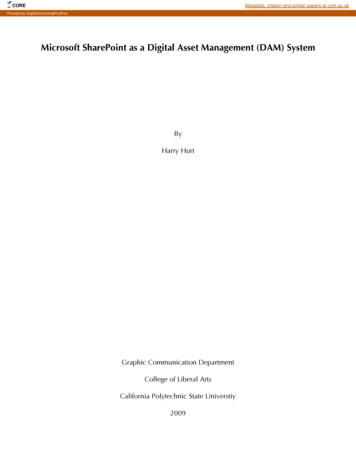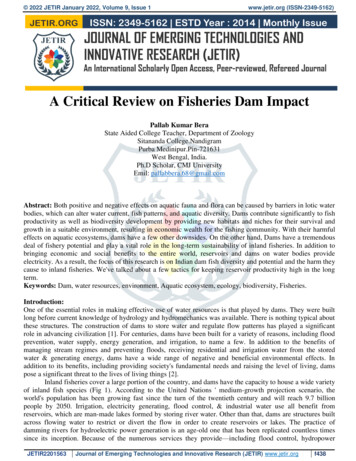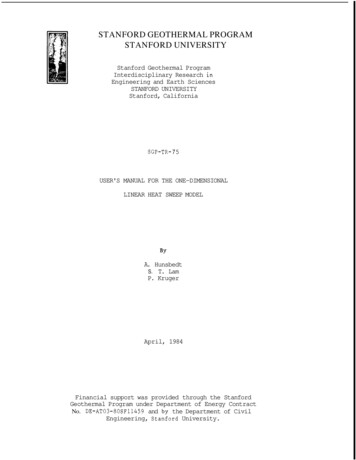
Transcription
9/4/2015Some Dam – Hydro NewsTMAnd Other StuffiQuote of Note: “Do not let what you cannot do interfere with what you can do."-- John WoodenSome Dam - Hydro News Newsletter Archive for Back Issues and Search http://npdp.stanford.edu/Click on Link (Some Dam - Hydro News) Bottom Right - Under Perspectives“Good wine is a necessity of life.” - -Thomas JeffersonRon’s wine pick of the week: 2012 Columbia Crest US Red Blend "H3 Les Chevaux"“No nation was ever drunk when wine was cheap.” - - Thomas JeffersonDams:(100 and still ticking. Beautiful dam! Not a positive story.)Todd Shallat’s Terra Idaho history column: Arrowrock at 100By Todd Shallat, Special to Treasure Magazine, August 22, 2015, idahostatesman.comThe Great Pyramid of the Boise River — thetallest dam on the face of the Earth,staggering and monumental —overshadowed even the feats of thePharaohs as an icon of human triumph. Sosaid a man named Moses at the 1915dedication of Arrowrock Dam. Gov. MosesAlexander, a Bavarian-born Jew, tipped hishat to “the strength of the people” and ledthe faithful in song. “My country ’tis of thee,”he sang in tune with Idaho farmers. Beforethem the arching Goliath shot streamsthrough cast iron valves. One million tons ofconcrete. Two hundred sixty rail car loads of1Copy obtained from the National Performance of Dams Program: http://npdp.stanford.edu
sand and Portland cement. Plugging and pooling the granite canyon for 18 slackwater miles,Arrowrock held enough water for 200,000 settlers on 240,000 sagebrush acres — enough water,said Alexander, to bloom the Garden lost to the fall.Sunday, Oct. 4, 2015, marks 100 years to the day since the epoch of high-rise concrete dawnedat Arrowrock Canyon, forever transforming the West. Plenty since that time has been said aboutdams as engines of progress. Less has been said about the revenge of technological systems —their costs and consequences, and the judo trick through which a system designed for a loftypurpose sometimes flips the results.The Snake River Plain with its fertile valleys once seemed ideal for irrigation, but to unlatch thepurse of Congress, the bombast had to be strong. Engineer Frederick H. Newell, the founder andfirst director of the U.S. Reclamation Service, saw in the Arrowrock project a masculine future ofpulleys, wheels and bearings, a future in which the slide rule would replace the rifle as a means ofsocial control. Manly feats of muscular science framed the local reporting. “It had been a man’stask,” said Boise Capital News after the dam’s dedication. Newell’s colossus, added the IdahoStatesman, was “strong,” “firm” and “robust.” Through Arrowrock, the engineers preached agospel that Theodore Roosevelt called Bull Moose Progressivism. Its higher purpose, said Newell,was “to bring about a condition whereby that land shall be put into the hands of the small owner,whereby the man with a family can get enough land to support that family.” Settlers responded ina rush to the Boise Valley as the Great War in Europe pumped the demand for Idaho crops. Evenwhen prices fell, when the dream went sour and dust took back the valley, the commissioner ofreclamation defended the engineering, calling dams “an unquestioned success.”Today with Anderson Ranch and Lucky Peak plus three big dams on the Payette River, the U.S.Bureau of Reclamation’s Boise-Payette Project claims 1.2 billion in annual yield from cattle andcrops. Add 13 million from hydroelectricity and 30 million from beaches and boating. Add 170million for allegedly sparing the valley damage from river erosion and floods. Karl Ames of Boise,a bureau engineer and spokesman, seemed perplexed by my request for Arrowrock cost-benefitdata. “Imagine the valley’s economy without Reclamation’s infrastructure,” Ames said. Yes, thefeds fronted the construction money, but the return on that investment, says Ames, has been onehundred-fold.But always there are mirages in deserts. An official history of the Boise Project details the tonnageof concrete. No mention is made of Heartbreak Row, the project’s hard-luck nickname; nothingabout the summer of 1917 when the failure of the main canal destroyed Canyon County’s wheatcrop; nothing about the boosterism that oversold the amount of available water, or about thedefection of Arthur P. Davis, once Arrowrock’s chief engineer, who later denounced his formeremployer for “blasted hopes” and “misrepresentations.” In 1924, as Davis vented in Salt Lake City,the U.S. Fact Finding Commission presented an audit of the battered bureau. Everywhere belowfederal dams the commissioner found “shacks instead of houses bareness instead of comforts;cold instead of warmth mortgages and foreclosures instead of growing bank accounts.” Newmega-marvels of mass at Boulder Canyon (Hoover), Grand Coulee and Shasta mostly restoredthe bureau’s standing. In the Eisenhower years, however, battles at Hells Canyon and Echo Parklaid bare the dam economics. Free-market hawks cried foul on the bigger-is-better bias in thebureau’s cost-benefit data. In 1977, President Carter unveiled a hit list of dams to bedecommissioned. Public hearings blasted tycoons and cattle barons who posed as threadbarefarmers in order to siphon the subsidized water meant for small-acreage farms. In 1982, theReagan administration renegotiated the quid-pro-quo: Big farms could still get water but the fedswould clamp down on their loans.Gaps, however, remain between the law and its implementation. “Deadbeat Dams” (2015) depictsthe bureau as a ham-handed giant, its “nobility” a glutton for pork. “We need to stop catering,”says author Daniel Beard, a Clinton-era commissioner of reclamation. Otherwise, urbanpopulations will suffer. The Boise River, dewatered, will wander like a lazy bayou. Trout streamswill stagnate and die. “We set out to tame the rivers,” wrote Marc Reisner in “Cadillac Desert”(1986). “We set out to make the future of the American West secure; what we really did was makeourselves rich and our descendants insecure.” For richer or poorer, the 1915 sensation still2Copy obtained from the National Performance of Dams Program: http://npdp.stanford.edu
freights a heavy tonnage of hope and fear and scientific conjecture. For Gov. Butch Otter and fiveirrigation districts, the hope is that the feds will cover the cost of 74 vertical feet added to theaging dam. For the U.S. Army Corps of Engineers, the fear is that failure to raise the dam wouldendanger housing in the crowded floodplain. For Idaho Rivers United, the conjecture is thatriverfront easement would tax the environment less than raising the dam. Arrowrock at 100remains a beast and a benefactor. Mythic, the structure remains much like Moses saw it: asublime manifestation of cultural and political values, a pyramid to which all Boiseans contribute astone. Todd Shallat, Ph.D., directs the Center for Idaho History and Politics at Boise StateUniversity.Repairs continue at Cannonsville DamJoe Mabel The Cannonsville Reservoir is shown in this 2013 aerial photo., August 26, 2015, thedailystar.comThe second stage of repairs at theCannonsville Dam was completed Tuesday,according to a media release from the NewYork City Department of EnvironmentalProtection.On Tuesday morning, engineers sealed shutthe three boreholes that had allowed cloudywater to discharge into the West BranchDelaware River from July 8 to Aug. 1. Theboreholes were created as part ofpreliminary work to construct a hydroelectricfacility at the dam, the DEP announcedpreviously. Testing was underwayWednesday to ensure the repairs wereeffective.Meanwhile, DEP is decreasing pumping from a series of relief wells, which were installed torelieve pressures from the underground aquifer that was pushing turbid water into the river. Flowfrom the relief wells is expected to be stopped by the end of the week, DEP said."Intensive" monitoring at the site will continue throughout the repair work, DEP said in the release.These efforts include 24-hour observations by on-site staff and surveillance cameras, dailyengineering inspections, and near real-time monitoring of turbidity and safety instruments insideCannonsville Dam.(Don’t think he wants the dam removed.)Letter: Removal of Scoby Dam is not the right answerbuffalonews.com, Aug 27, 2015Let me explain why removal of Scoby Dam is a disaster for the environment. The main fish thatwill enter the Upper Cattaraugus Watershed will be the steelhead trout. These fish are not nativeto our ecosystem. They are genetically from the Chambers Creek strain – West Coast,Washington State. They are big fish that grow to 30 inches and can weigh 10 pounds. These fishare predatory – like all trout – and feed on smaller bait fish (minnows, chubs, dice, etc.) They don’task these fish who they are, so they also consume small trout when and where available. Thereinlies the problem. The Upper Cattaraugus Watershed and its tributaries – Clear Creek, Elton, LimeLake Outlet, etc. – are loaded with these small, young trout. It’s their home; it’s their spawning andgrowing area. With the dam gone, you can kiss all these fish goodbye.I attended many of the Scoby Dam meetings. It doesn’t take a sportsman long to figure out thereal reason for its removal. Crowds will come, motels, restaurants and stores will get increasedbusiness. It won’t be too many years until these streams are “lease only” fishing areas like in theSalmon River/Pulaski area of New York State. Could somebody please explain to me how thisbenefits the environment? Let’s be logical, the only environment that’s benefitting is the3Copy obtained from the National Performance of Dams Program: http://npdp.stanford.edu
pocketbook, not the fish. New York State’s latest concern, and rightfully so, is invasive species.Recently, there have been signs all over our waterways telling us to wash our boat, clean your hipboots and don’t put anything in the water. You don’t think invasive species aren’t going to enterthe upper watershed when the dam is adding a passage ramp? The Department of EnvironmentalConservation might as well put another sign up at the dam saying “invasive species, enter here.”Based on what I know and what will happen here, I wish that our conservation personnel wouldact in the interest of our environment and wildlife and not the revenue at stake. Dennis Kujawa,East AuroraHydro:(Doesn’t look like a powerhouse, but it is! Hydro and solar!)Pepperell Hydro uses water, sun to power gridBy Anne O'Connor, nashobapub.com, 08/21/2015PEPPERELL -- The folks at Pepperell Hydrohave been generating power for several years.This summer, they added anotherenvironmentally-friendly power generator. Thehydroelectric plant dates from 1921 when itwas built to power the paper mill. Now,Pepperell Hydro also sends solar-generatedelectricity back to the grid, thanks to a newarray of solar panels. "Green is green," saidPeter B. Clark, president of Swift RiverCompany. Pepperell Hydro is part of a small group of hydroelectric plants in Massachusettsmanaged and operated by Swift River.The new array will reduce the plant's operating expenses through the energy credits it will receive,he said. Like the hydropower the plants makes, the solar power is from a renewable source."Everything goes up to the grid," said Martha Brennan, director of regulatory affairs at Swift River.The hydropower is sold to the Reading Municipal Light Department. The solar goes on the gridthrough National Grid. Even though the hydro plant generates huge amounts of electricity, theplant still needs to purchase electricity for day-to-day operations. The transformers must staywarm and the lights need to be kept on even when the plant is not generating electricity, saidQuincy Vale, director for business development at MassAmerican Energy. MassAmericanspecializes in commercial solar installations, usually 100 kilowatts and larger, Vale said. "This isone of our smaller ones," he said.The new solar panels on the roof of the red garage beside the bridge on Main Street will generate13 kilowatts, two to three times the average size of a residential installation. The amount was lowenough that Pepperell Hydro was not affected by the net metering cap that put the brakes on aplanned solar installation on the capped Pepperell landfill. As long as a commercial array that isconnected via a three-phase power connection is under 25 kilowatts, it does not hit the limit, Valesaid. The installation in Pepperell presented its own challenges. "We didn't have an easy way tointerconnect that hydro facility to the grid," Vale said. The plant has a high-voltage connection tothe grid, but the solar needed a normal connection from the street. "We looked at a whole bunchof different things for Pepperell Hydro," Vale said. Rather than run a power line from the bridgealong the new penstock to the plant, putting the solar panels on the roof of the garage madebetter economic sense, he said. The building already had three-phase power. The red garage isused to store materials to maintain the dam, Clark said. The dam regulates the water in PepperellPond, Brennan said. The hydro-plant uses a run-of-the-river model, keeping the water level in the4Copy obtained from the National Performance of Dams Program: http://npdp.stanford.edu
pond at a consistent level. In the earlier days, when the plant was generating power for the papermill that owned it, the water levels would change, she said. Now, it is more environmentallyfriendly. Vale was very enthusiastic about the Pepperell installation. The American-made panelsgive the best return on investment, he said. Thanks to innovative wiring, they can generateelectricity even when only part of the panel is in the shade. Snow will slide off easily because ofthe steep angles of the panels. Fire is no danger because the system cannot spark or arc, Valesaid. A typical commercial installation operates at 600 to 1,000 volts, he said. Pepperell Hydro'sinstallation comes in at 57 volts, not high enough to support an arc. The installation is a goodinvestment for the owners, Vale said. It will cover 50 or more percent of their electricity costs.And, he said, it's good for the environment.(Pumped storage doing its thing.)How Edison uses water to store excess powerBy IVAN PENN contact the reporter, latimes.com, 8/23/15BIG CREEK, Calif. — Nestled high inthe Sierra mountains among the pineand fir trees, a little-known man-madewonder may help resolve a pressingenergy concern: how to store windand sun power that the gridincreasingly can't handle.For nearly three decades, water hasflowed down from the mountains'artificial lakes to spin an electricitygenerator at the John S. EastwoodPower Station, the crown jewel ofSouthern California Edison's BigCreek hydroelectric system. The underground powerhouse — sheltered in a cavern blasted fromgranite bedrock — has produced cheap and reliable electricity. And when windmills, solar panelsand other sources generated more power than Californians needed, the excess electricity wouldspin the generator in reverse to pump the water back up the mountain to a reservoir to hold forlater; called "pump storage," it's a way of stockpiling electricity.Then four years of relentless drought took its toll. This year, for the first time, Southern CaliforniaEdison probably will get no electricity out of its prized Eastwood facility. The water has fallen solow at a key source, Shaver Lake, that giant granite boulders are visible along the shoreline."The last three or four years are probably the worst I've seen in my life," said 60-year-old JoelPreheim, Edison's production manager at Big Creek, who first moved to this town the locals callthe "Camp" when he was 3. The Eastwood pump station's idleness comes at a tricky time.Solar and wind power production is exploding as the state pushes ambitious renewable energygoals. To help manage and store that electricity — created only when the sun shines and the windblows — California energy officials have begun studying large-scale pump operations, accordingto a letter sent to regulators last month by the head of the agency that handles long-distancetransmission for most of the state. The entire energy industry is racing to unlock the mysteries ofaffordable energy storage. Billionaire Elon Musk is investing heavily in developing better batteries.Others are looking at unusual approaches, including using solar energy to produce hydrogen gas,which can be saved for when its needed. Some hope to rely on the kind of hydro pump storageprovided by Eastwood. State regulators in October 2013 set a target for utilities to bring 1,325megawatts of new storage online by 2024. It would take more than six times Eastwood's 200megawatts of hydro storage to meet that goal."The vast majority of existing electricity storage is pumped hydro," said Lucas Davis, aneconomics professor at UC Berkeley. "But it makes me nervous when we start talking about hydrobeing needed," Davis said. "During drought years, that's a killer." The heart of the 277-millionEastwood power plant lies behind a towering security gate. The trip down a long cave to the5Copy obtained from the National Performance of Dams Program: http://npdp.stanford.edu
turbine that spins 200 feet beneath Shaver Lake feels like a scene from "Journey to the Center ofthe Earth." At the end of the trip is the generator, surrounded by a trough where water flows,causing the turbine to spin. The ability to recycle water through the pump station is what hasmade it such an attractive concept. "That's the nice thing about hydro," Preheim said. "You canuse it over and over and over." Edison began to draw water to feed the first of Big Creek's ninepower houses about 100 years ago. The first power lines — then the world's longest — reachedLos Angeles from Big Creek in 1913. "Most technologies don't last 100 years," Preheim said. Atone time, Big Creek served as Edison's third-largest source of electricity generation, behind theSan Onofre nuclear plant and Mohave coal power station. Big Creek has outlived them both. Now,second to Edison's 1,054-megawatt Mountainview natural gas plant, Big Creek accounts for 5%of the utility's electricity generation. Unlike natural gas and nuclear plants, Eastwood and otherhydro facilities can ramp up in as little as six minutes. "Hydro is a very important resource," saidAndrew McMillan, Big Creek's manager of dispatch operations. "We're a life boat." But hydro isvulnerable to the vagaries of mother nature. "The water level," McMillan said of Big Creek's lakes,"is down 33.7 feet." That adds another wrinkle to the complexity of a state electricity system thatalready is facing unprecedented change. State regulators were warned in late July that managingwind and solar power will soon get much more complicated.The warning came from Steve Berberich, chief executive of the California Independent SystemOperator Corp., which is responsible for making sure that supply and demand are alwaysperfectly balanced on the transmission system serving about 80% of the state.At times, solar and wind create excess generation that Berberich's office must figure out how tomanage. Just as insufficient electricity causes problems — power reductions and blackouts — toomany electrons can damage the power grid and anything connected to it. "Energy storage, with itsunique ability to both consume excess renewable energy, and to quickly inject clean energy backonto the grid to meet ramping and peak demand needs, has the potential to be a cornerstone ofthe new electric network," Berberich wrote to the California Public Utilities Commission. Butcapturing, and later releasing, extra electricity in large amounts at an affordable price requirestechnology that is still being developed. The fact that pump storage already exists makes it anattractive option when water is plentiful, leading Berberich to alert the utility regulators that hisoperation will be studying the benefits of deploying pump storage on a large scale.When too much electricity is being produced, "we just can't turn resources on and off to fix theoversupply," said Steven Greenlee, a spokesman for the California Independent System Operator,which doesn't own the power sources. The first tool currently available is to find electricitygenerators to submit bids to reduce their output, Greenlee said. If that doesn't work, then there'san effort to export the electricity elsewhere — often at negative prices, which means powergenerators pay someone to take their electricity. In an emergency, the system operator hasauthority to order any power source to cease production and disconnect from the grid. "But this isa last resort and not something we want to do," Greenlee said. The preference is to capture theexcess generation. The urgency to do so is growing with more utility-scale wind and solar projectscoming online and with more homeowners and businesses setting up rooftop solar installations. Inspring 2014, Berberich's office recorded four instances in which solar and wind generation had tobe cut, for a total of about six hours, because too much power was produced. The combinedreduction was more than 1,700 megawatts. In such cases, Berberich sees pump storage facilitiessuch as Eastwood as helping prevent loss of the excess electricity.But relying on hydro storage as a significant part of the answer concerns some experts such asDavis, the UC Berkeley professor. He said the drought has shown that hydro needs seriousreview, as do other energy storage methods when it comes to cost and efficiency. "I don't think weknow yet," Davis said of the focus on hydro storage, "if this is good public policy or not."(Big bucks for a small town.)Judge sides with Vermont town in hydro station disputeBy - Associated Press - August 25, 2015, washingtontimes.comBELLOWS FALLS, Vt. (AP) - A judge has ruled in favor of a Vermont town in a dispute withenergy giant TransCanada over the tax assessment of a hydroelectric station. The Rutland Herald6Copy obtained from the National Performance of Dams Program: http://npdp.stanford.edu
reports (http://bit.ly/1KgCTJR ) a Superior Court judge set the value of the Bellow Falls hydrostation in Rockingham at 108.5 million. TransCanada Hydro Northeast thought it was worthabout 40 percent less. The station is viewed as one of the most efficient and productive on theConnecticut River. Officials say it brings in 11 million to 13 million annually. The issue at stakewas millions of dollars in annual taxes. TransCanada pays municipal taxes to the village ofBellows Falls and the town of Rockingham. Rockingham officials estimated that if they lost thecase they’d owe the company 3.6 million for three years of overpaid taxes.(Canoeing up stream without a paddle.)Proposal for turbines at St. Anthony Falls is already generating plenty ofoppositionBy Peter Callaghan 08/25/15, minnpost.comThe Minneapolis Park & Recreation Board and the Minneapolis City Council are concerned theproject threatens the continued redevelopment of the area for parks and historic interpretation onthe west bank of the river. A Minneapolis-based company thinks its proposal for a newhydroelectric facility at St. Anthony Falls is exactly what the region is seeking: renewable andsustainable energy that could replace electricity now being generated by fossil fuels. At the spotwhere the city’s industrial founders used water power to make Minneapolis the flour milling capitalof the world, Crown Hydro has proposed “to provide clean energy for generations to come,” byredirecting Mississippi River flows to new turbines located near the now-mothballed navigationlock, the company states in promotional materials touting the project. So what’s not to like? Whenan initial version of the plan was first introduced nearly 25 years ago, said Crown Hydro CEOWilliam Hawks, “it was balloons and hot dogs.” But that was two-plus decades and at least twoiterations of the project ago. Now, at least according to some local governments and someresidents, there’s quite a bit not to like.The Minneapolis Park & Recreation Board and the Minneapolis City Council said last week thatthey have major concerns with the plan. For one, the project threatens the continuedredevelopment of the area for parks and historic interpretation on the west bank of the river.Another concern: that construction of the underground water channels and installation of two 1.7megawatt turbines could damage the sandstone and limestone foundations of the shoreline,including that under the Stone Arch Bridge. A Minneapolis City Council member even raised thespecter of the project causing “the total decimation of water flow over the falls. “It would make thefalls dry for certain periods of the year,” said Council Member Jacob Frey at a meeting of thecouncil’s Intergovernmental Relations Committee earlier this month. The water-flow issue is indispute. Crown Hydro proposes operating the turbines only during periods of average or aboveaverage flows and shutting down during low-flow periods; it is a signatory to the Mississippi RiverSystem-Wide Low Flow Management Plan [PDF]. But raising the possibility of dry falls and adamaged Stone Arch Bridge is a fast way to counter Crown’s talking points, which includereducing carbon footprints and renewable energy.A long historyThe full City Council agreed with the Intergovernmental Affairs Committee recommendation tosubmit its concerns to the Federal Energy Regulatory Commission (FERC), which decides toapprove or deny applications such as Crown’s. “Generally speaking, there needs to be moreclarity regarding the full range of impacts to this historic area including noise, vibration, visual,structural and accessibility, among others,” the resolution stated. “This is a vital natural andhistoric resource area and this project is potentially disruptive to it — both during construction andoperation.”The Minneapolis Park and Recreation board also voted Wednesday to submit its concerns toFERC — and to file a formal complaint over the way Crown Hydro’s application has beenprocessed. The proposal has taken a long and winding path to even get this far in the FERCprocess. Technically, Crown’s application is an amendment to a previous license application. In1999, Crown was granted exclusive rights to develop a hydropower facility in the Mill Ruins areaof the river. Initially the turbines and generators were to be installed in the basement of the historic7Copy obtained from the National Performance of Dams Program: http://npdp.stanford.edu
Crown Roller Mill Building, adjacent to the upper falls. Once considered one of Minneapolis’finest mills, Crown Roller Mill stopped using water to power the mill in 1933 and stoppedproduction in 1953. After a 1983 fire, the building was saved from demolition and renovated,complete with a reconstructed copper mansard roof. It’s now an office building.When a deal couldn’t be reachedwith current owners of the building,though, Crown Hydro amended itsplan — with Park Boardencouragement — to locate theturbines on land owned by the ParkBoard near the former Fuji-YaRestaurant. After FERC ruled thateminent domain powers that aresometimes available to help powerprojects could not be used againstparkland (and after negotiationsbetween Crown and the park boardfailed), that request was denied byFERC in 2005.The current proposal would place theProposed site of the hydroelectric facility at St. Anthony Falls.turbine and powerhouseunderground on Army Corps of Engineers property adjacent to the lock control building. An intakestructure would be located on the riverbank side of the guide wall at the lock facility. After passingthrough the turbines, 40 feet below ground, water would flow through a new 16-foot diameterconduit that would snake beneath the Corps property and the approaches to the Stone ArchBridge before being discharged back into the river.Hawks said he doesn’t fault the Park Board for not agreeing to the earlier plan, saying it lacks staffexpertise that would have increased its comfort with overseeing a hydro project. “It’s the oppositewith the Corps,” Hawks said. “They’ve done this all over the country. That’s why we feel goodabout it.” Hawks said that once built, visitors to the area “won’t even notice” the facility. Theturbines are vibration free and can’t be heard over the flow of the water. Crown has an agreementto sell the power generated — enough to power more than 2,000 homes — to Xcel Energy, whichoperates a generating facility on the east bank of the falls. Hawks said he is prepared to answerthe questions raised by commenters and FERC. “That’s as it should be,” Hawks said. “But I can’timagine there’s anything that would be a show-stopper.” If FERC gives approval, the 10 millionproject could be completed in six months. The turbine and generators have already beenpurchased, he said.Other projects also proposedAnother proposal to use water power for electricity is coming from the redeveloper of the PillsburyA Mill, this one using the power generated to provide electricity to the new artists lofts beingcompleted there. Another proposal to put turbines inside the lock, which closed to navigation inJune, has been rejected by FERC but applicant Symphony Hydro is reapplying. The Crownproject has the support of the Minneapolis Regional Labor Federation, according to Crown’swebsite, and has attracted kind words from some environmentalists. Opponents, however, haveboth procedural and substantive objections. Doug Verdier, of Minneapolis Park Watch, wrote thatthe project has changed so much since 1999 that Crown should be required to start with a newapplication and not be allowed to amend that earlier license. “It clearly is a new project and, asFERC has pointed out repeatedly, it should be submitted as a new project,” Verdier wrote on thePark Watch website. “An amendment of the existing license is not appropriate.”The Park Board wrote in 2013 that “Crown’s latest attempt to style a completely new
The Great Pyramid of the Boise River — the tallest dam on the face of the Earth, staggering and monumental — overshadowed even the feats of the Pharaohs as an icon of human triumph. So said a man named Moses at the 1915 dedication of Arrowrock Dam. Gov. Moses Alexander, a Bavarian-born Jew, tipped his hat to "the strength of the people .










